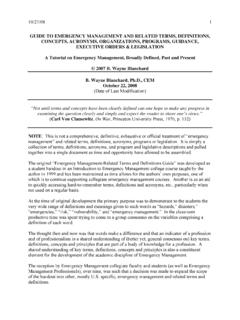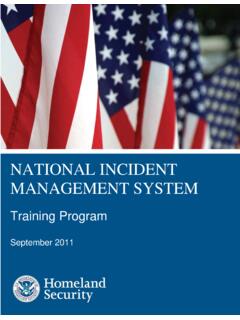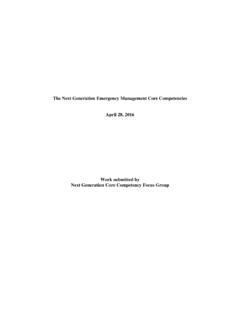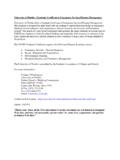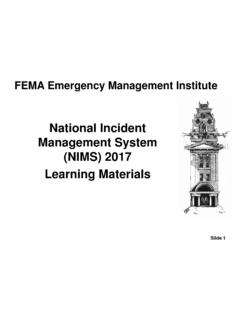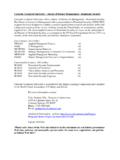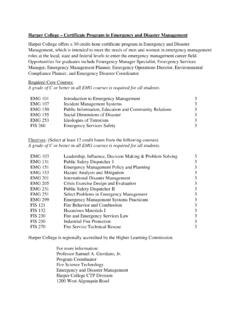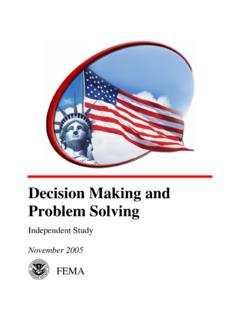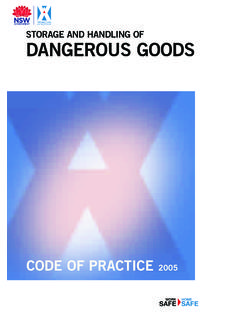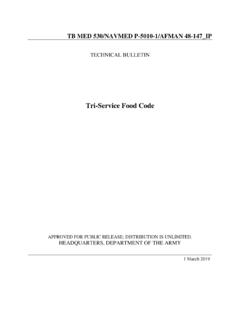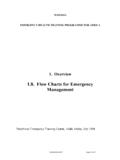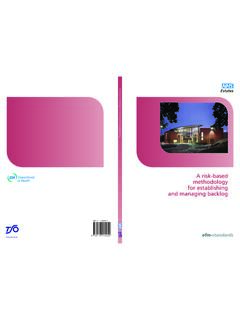Transcription of Sample Childcare Emergency Operations Plan
1 Sample ChildcareEmergency Operations PlanNovember 2011 For Training Purposes Only with Multihazard Planning for Childcare Springfield Child Care Center Emergency Operations plan November 2011 Intentionally Left Blank i Table of Contents Signatory Page Basic plan I. Introduction .. 3 II. Concept of Operations .. 7 III. Organization and Assignment of Responsibilities .. 8 IV. Direction, Control, and Coordination .. 10 V. Communications .. 11 VI. Administration, Finance, and Logistics .. 14 VII. plan Development, Maintenance, and Distribution .. 15 VIII. Authorities and References .. 17 Functional Annexes Shelter-in-Place 20 Evacuation Procedure .. 21 Hazard- and Threat-Specific Annexes Flood (Near or on Grounds).. 25 Hazardous Materials .. 27 This document presents excerpts from a Sample child care Emergency Operations plan (EOP). Common procedures, such as evacuation and parent-child reunification, may differ at the local, tribal, and State level, so they have not been included in the annexes although they are referenced throughout the plan .
2 It is recommended that planners coordinate with local and tribal law enforcement, fire, and Emergency managers when developing these procedures. Appendixes are mentioned in the Sample EOP for reference purposes only; no appendixes are included in the Sample plan . This Sample plan is for training purposes only and is based on a fictional child care facility and county. It is important to tailor all Emergency Operations plans to the specific hazards and needs of your jurisdiction and community. ii Intentionally Left Blank iii SIGNATORY PAGE This Emergency Operations plan has been completed and approved through a collaboration of efforts in the community, including: Jamie Flowers Director Bill Jacobson Maintenance Lead Jennifer Paprocki Teacher Nathan Montgomery Nurse Angela Cloman Parent Mark Wallis Fire Chief Kristin Toliver Police Chief Lisa Pollard Emergency Manager iv Intentionally Left Blank Springfield Child Care Center Emergency Operations plan Basic plan 1 Basic plan Springfield Child Care Center Emergency Operations plan Basic plan 2 Intentionally Left Blank Springfield Child Care Center Emergency Operations plan Basic plan 3 I.
3 INTRODUCTION A. Purpose of the plan The purpose of the Springfield Child Care Center Emergency Operations plan (EOP) is to identify and respond to incidents by outlining the responsibilities and duties of Springfield Child Care Center and its employees. Developing, maintaining, and exercising the plan empowers employees in an incident to act quickly and knowledgably. In addition, the plan educates staff, children, parents, and other key stakeholders on their roles and responsibilities before, during, and after an incident. This plan provides parents and other members of the community with assurances that Springfield Child Care Center has established guidelines and procedures to respond to incidents/hazards in an effective way. The developed guidelines and procedures for dealing with existing and potential incidents are defined in the plan below. The basic plan and the functional and hazard-specific annexes outline an organized, systematic method to mitigate, prevent, protect against, respond to, and recover from incidents.
4 S taff members have been trained to assess the seriousness of incidents and respond according to these established procedures and guidelines. Springfield Child Care Center regularly schedules training for staff. Lastly, developing, maintaining, and exercising the EOP increases Springfield Child Care Center s legal protection. While no set of policies rules out the potential for legal problems, establishing procedures and guidelines on the best professional practices provides a margin of protection against liability. B. Scope of the plan The Springfield Child Care Center EOP outlines the expectations of staff; roles and responsibilities; direction and control systems; internal and external communications plans; training and sustainability plans; authority and references as defined by local, tribal, State, and Federal government mandates; common and specialized procedures; and specific hazard vulnerabilities and responses/recovery. Within this scope, the plan defines an incident and hazards as follows.
5 Incident: An incident is an occurrence natural, technological, or human-caused that requires a response to protect life or property. The director shall have the authority to determine when an incident has occurred and to implement the procedures within this Emergency Operations plan . Hazards: Hazards shall include situations involving threats of harm to children, personnel, and/or facilities. Hazards include but are not limited to natural, technological, and human-caused incidents. Hazards may require an interagency response involving law enforcement and/or Emergency services agencies depending on the size and scope of the incident. C. Situation Overview/Hazard Analysis Summary 1. Child Care Center Population Springfield Child Care Center s current enrollment is approximately 150 children from ages 18 months to 9 years. The center is located in a one-story building that was previously an elementary school. The children enrolled at Springfield Child Care Center are supported by a committed staff.
6 Springfield Child Care Center Emergency Operations plan Basic plan 4 A roster for each room is available in the main office. The roster is also located in Appendix A as a reference. [Note: Appendix A is not included in this Sample plan .] Springfield Child Care Center is committed to the safe evacuation and transport of all children and staff. Children, especially toddlers, are considered to have access and functional needs and this plan addresses those needs in addition to providing additional guidance for children/staff with: Limited English proficiency, Blindness or visual disabilities, Cognitive or emotional disabilities, Deafness or hearing loss, Mobility/physical disabilities (permanent and temporary), and Medically fragile health (including asthma and severe allergies). The center s current enrollment of children with access and functional needs identified above is approximately 12; however, this number will fluctuate. Children and/or staff may require additional assistance if they are temporarily on crutches, wearing casts, etc.
7 Classrooms containing children and staff that require additional assistance during an incident will be noted by an asterisk next to the room number on the roster. The list of children and staff with the identified access and functional needs along with their locations can be found in Appendix B. Staff members that have been trained and assigned to assist those with access and functional needs during drills, exercises, and incidents are listed in Appendix B. [Note: Appendix B is not included in this Sample plan .] 2. Building Information Springfield Child Care Center is located on a 2- acre lot and includes one building, three playgrounds, and two parking lots (one for staff and one for visitors). A map of the child care center building annotated with evacuation routes, shelter locations, fire alarm pull stations, fire hydrants, fire extinguishers, first aid kits, hazardous materials storage, and utility shutoffs is included in Appendix C . All staff members are required to know these locations as well as how to operate the utility shutoffs.
8 [Note: Appendix C is not included in this Sample plan .] 3. Hazard Analysis Summary Springfield Child Care Center is exposed to many hazards, all of which have the potential for disrupting the child care center, causing casualties, and damaging or destroying public or private property. In June 2010, a planning team of staff members, parents, and Emergency personnel completed a thorough hazard analysis to identify any circumstances in the child care center or near the site that may present unique problems or potential risk to people or property. The interior and exterior portions of the building and the grounds have been assessed for potential hazards that may impact the site, the staff, and the children. Identified hazards have been assessed by risk and likelihood and ranked accordingly. The table on the following page briefly discusses Springfield Child Care Center s high-priority hazards including flood, severe storm, fire, hazardous materials, missing child, and intruder.
9 Springfield Child Care Center Emergency Operations plan Basic plan 5 Table 1. High-Priority Hazards Flood Flooding is a natural feature of the climate, topography, and hydrology of Springfield and its surrounding areas. Flooding predominates throughout the winter and early spring due to melting snow, breakaway ice, and rainy weather. Flooding could threaten the safety of children and staff whenever storm water or other sources of water threaten to inundate the grounds or building. Flooding may occur if a water pipe breaks or prolonged rainfall causes urban streams to rise. Flooding may also occur as a result of damage to water distribution systems such as failure of a dam or levee. Severe Storm Springfield and its surrounding areas are vulnerable to severe local storms. The effects are generally transportation problems and loss of utilities. During the 2006-07 winter storms, high snowfall and cold temperatures resulted in significant snow accumulations.
10 The accumulations aggravated by rain, drifting snow, and ice in roof drains caused excessive weight and the collapse of a storage shed located near the building. The collapse resulted in over $3,000 in damage to arts and crafts supplies. Fire Fire hazards are the most prevalent types of business disaster. Fire is of particular concern to young children because it is difficult for young children to escape from fire because they lack the motor skills and mental capabilities needed and may be unable to awake from a sound sleep. A 2003 fire at Mitchell School in Columbia County reiterated the importance of fire preparedness and prevention efforts. Hazardous Materials Hazardous materials can be found in all homes and businesses and include: cleaning products, pesticides, paint supplies, lawn and garden products. It is important to ensure hazardous materials are clearly marked, kept in their original containers, and out of children s reach. Currently, ammonia, chlorine , and propane are all used and stored at the child care site.
